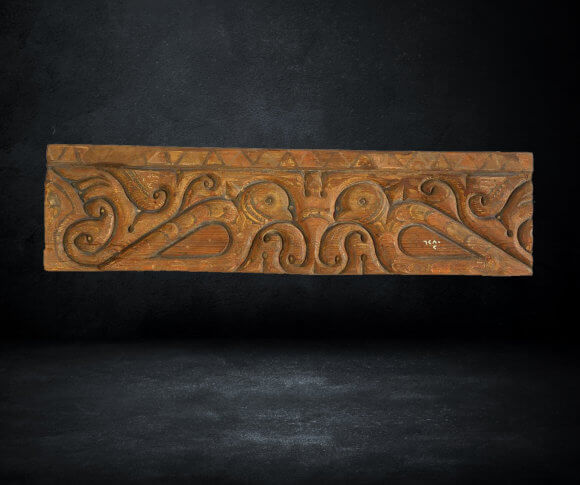
"Wooden panel carved and painted,
decorated with birds
Egypt - Tulunid
3rd A.H / 9th A.D century
MIA no. 6280-2"
"These wood panels were probably part of a wall casing; some traces of colors are shown on the friezes. The opposing bird motifs were executed amidst intersecting vegetal decorations. This technique became known as slanted or beveled carving, after the transmission of the Samarra style to Egypt in the Tulunid period (254-292AH/868-905AD). These ornamentations are of a Sasanid inspiration characterized by the drawing of the tree of life (Homa or Soma) and decorating using affronted birds against a vegetal background.
hall 1"
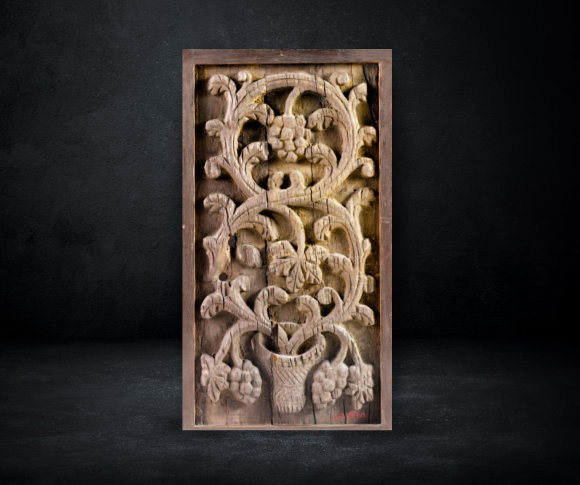
"Wooden panel
decorated with carved floral and animal figures
Egypt or Syria - Umayyad
2nd A.H / 8th A.D century
MIA no. 15468"
"The artifacts dated to the end of the Umayyad period and beginning of the Abbasid period are characterized by vegetal decorations which imitating nature and carry a clear Hellenistic inspiration that is a mixture of Western Byzantine and certain Eastern Arts, which first appeared in Alexandria. This was typified by decorations involving grape clusters coming out of what looked like flower vases. These decorations resemble those adorning the Aqṣā Mosque in Jerusalem, particularly those executed during its restoration in the reign of the ʻAbbasid caliph al Mahdy (158-169 AH).
hall 1
"
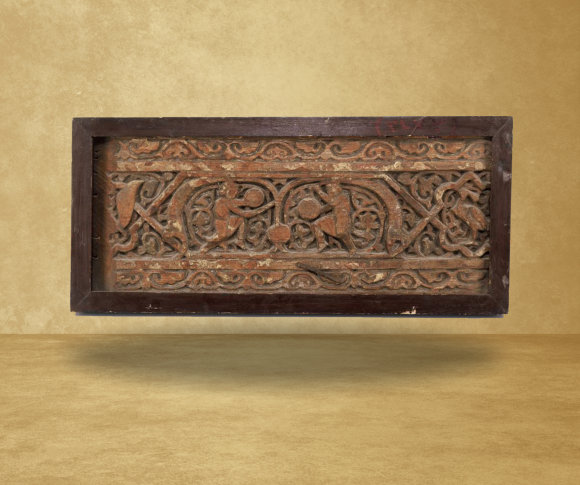
"wooden panel decorated with human, animal and floral decorations
Egypt – Fatimid
5th A.H /11th A.D century
MIA no. 3473"
"These panels once adorned the palaces of the Fatimid caliphs in al-Mu’izz street between Zweila and al-Futuh gates. The palaces were decorated with scenes from daily life drawn from hunting, music, dancing, and drinking activities. The decorations were applied in several layers, reflecting the artisan’s talent in the Fatimid period. Those panels were reused to decorate the huge architectural complex of the mamluk sultan al-Mansūr Qalāwūn in al-Mu’izz street in 684AH/1285AD
hall 3"
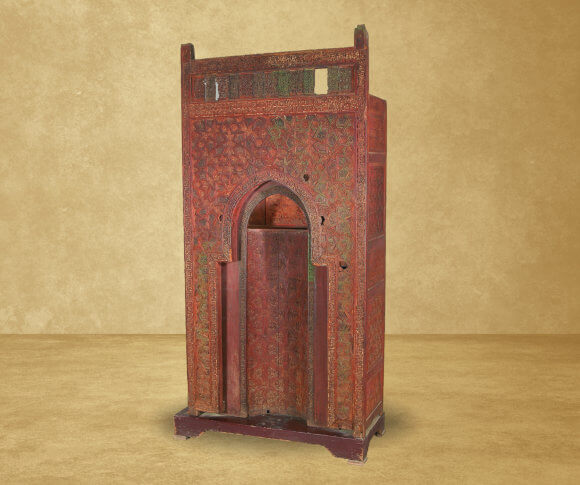
"Wooden portable Mihrāb from the Mausoleum of Sayyidah Ruqayyah
Egypt- Fatimid
6th A.H /12th A.D century
MIA no. 446"
"The wife of the Caliph al-Āmir bi’ Aḥkām Allah ordered the construction of this portable wooden Miḥrāb. Most probably this Mihrab was made in the reign of the caliph al-Fā’iz and his vizier al-Sāliḥ Talā’i‘ between 549-555 AH/1154-1160 AD. That is indicated in an epigraphic frieze of floriated Kufic on its façade. The four sides of the Miḥrāb are decorated with various vegetal motifs such as intricatel trilobed, and five- lobed leaves, clusters of grapes, as well as wooden inlays with poly-lobed star-shaped geometric ornamentation considered the first emergence of the uncompleted star-shaped dishes in the Fatimid period.
hall 4"
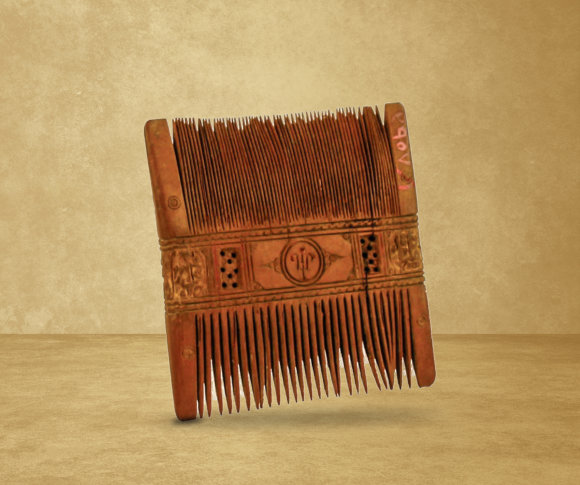
"The comb is considered one of the most important cosmetic tools. They were used for combing hair and beard in order to enhance the man’s external appearance. Each comb has teeth and the area between the teeth is usually adorned with various decorations.
hall 9"
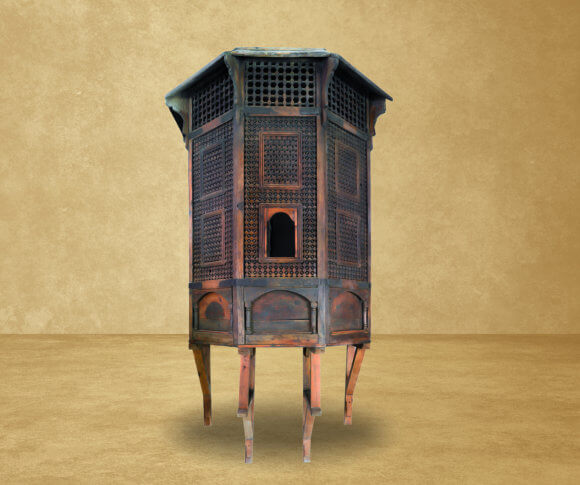
"Balcony, turned wood
The terms derived from Arabic root Sharaba, to drink and is thought to be connected with the practice of putting water jar
Egypt– Ottoman
11th - 12thA.H /17th - 18thA.D century
MIA no. 2923"
"This lattice-work Balcony decoration called “Mashrabiyyah” was widely used in the facades of the houses during the Ottoman period in Egypt. It enabled women to look through them and keep their privacy in the same time. Thus, the Mashrabiyyah became the best means of protecting the privacy of the household, in strict observance of the chastity principles of Islam. The term Mashrabiyyah derives from the word Sharābiyyah which refers to the place where the water jars used to be left, outside of the windows, in order to get cooler.
hall 11"
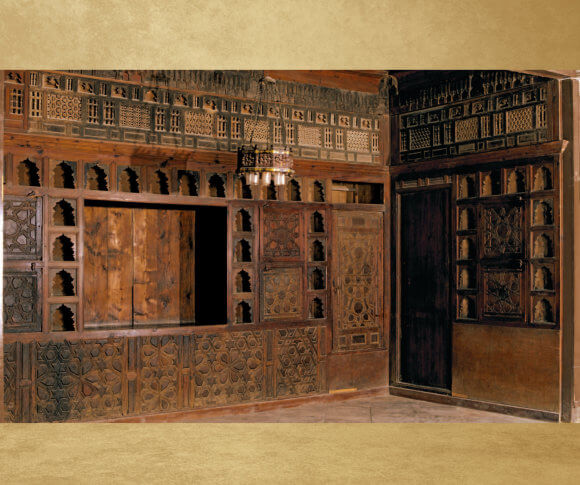
"Wooden casing of a reception hall in the house of Mazdani in Rosetta
Egypt – Ottoman-12th A.H / 18th A.D Century
MIA no. 1701"
"The wooden casing is decorated with foliate, and geometric motifs, in addition to small squinches
hall 16"
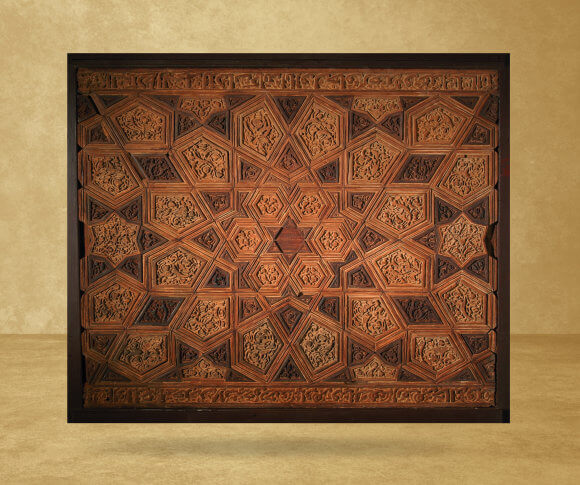
" wooden panel from the mausoleum of Imam al-Shafi‘i
Egypt –Ayyubid
7th A.H / 13th A.D century
MIA no. 408"
"The object reflects an assembly of wood panels forming a star pattern decorated with foliate designs, in addition to a frieze of naskkhi writing applied on floral background. Those panels were brought to the Museum from the dome of imam al-Shafi’i
hall 5"
"Wooden Cenotaph from al-Husayn mosque
(Near al-Azhar mosque)
Egypt- Fatimid or Ayyubid
6th A.H/ 12th A.D century
MIA no. 15025"
"This wooden cenotaph was brought from Ascalon to Egypt to be put in the mausoleum of Imam al-Husayn “May Allah be pleased with him” son of Fatima al-Zahra “May Allah be pleased with her” daughter of the prophet Muhammad “PBUH”. Some Quran verses could be explained as signs of Shiite doctrine and confirms a specific date at the end of the Fatimid period. Some researchers see that it dated to the Ayyubid period because its technique resembles that in the mausoleum of imam al-Shafi‘i . Its decoration is varied between geometric, floral, and epigraphic motifs harmoniously arranged to prove its artistic value
hall 18"